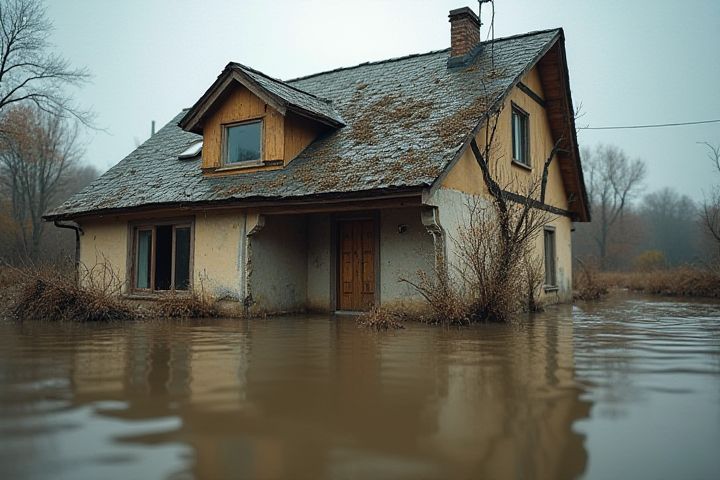
Your house might be sinking due to various factors, primarily related to soil conditions and structural issues. Poor drainage can lead to soil erosion, causing uneven settling of the foundation. Tree roots can also impact the soil's integrity, pulling moisture from the ground and destabilizing it. Other potential causes include plumbing leaks that undermine the foundation or expansive clay soils that shrink and swell based on moisture levels. It's crucial to conduct a thorough inspection to identify the specific cause and implement appropriate solutions to prevent further damage to your property.
Why Is My House Sinking
Soil erosion
Soil erosion, a significant factor contributing to house sinking, occurs when wind or water displaces soil particles, leading to the gradual loss of stability in the ground beneath your home. Factors such as heavy rainfall, poor drainage systems, and excessive landscaping can exacerbate erosion and compromise the foundation of your property. The soil's inability to provide adequate support results in settling or sinking of the house, which can manifest as cracks in walls, sloping floors, and other structural issues. You may need to consult a geotechnical engineer to assess the extent of soil erosion and implement appropriate mitigation measures to protect your home.
Poor drainage
Poor drainage can lead to significant issues, including soil erosion and water pooling around your home's foundation. When rainwater is not effectively channeled away, the soil becomes saturated, causing it to shift and settle unevenly. Studies show that approximately 30% of foundation problems stem from inadequate drainage systems, resulting in potential structural damage and increased repair costs, which can range from $2,000 to $7,000. Implementing effective drainage solutions, such as French drains or proper gutter systems, can mitigate these risks and protect your investment.
Expansive clay soil
Expansive clay soil is a significant factor in your house sinking, as it shrinks when dry and swells when wet, causing fluctuations in foundation stability. In areas where this type of soil is prevalent, approximately 20% of homes experience foundation issues due to clay expansion and contraction. Moisture content is crucial; if your drainage systems are inadequate, water can seep into the soil, leading to expansion and pressure on the foundation. Regular inspections and moisture control methods can mitigate the risks associated with expanding clay soil under your property.
Nearby construction
Nearby construction can significantly impact your house's stability, leading to settling or sinking foundations. Heavy machinery and excavation work can disturb the soil, altering its load-bearing capacity and potentially undermining your home's support. If construction projects are causing vibrations or removing soil, they can exacerbate any pre-existing weaknesses in your foundation. It's vital to monitor any changes in your home and consult a professional engineer to assess the structural integrity and recommend appropriate measures before the situation worsens.
Natural disasters
Your house may be sinking due to natural disasters like flooding, earthquakes, or landslides, which can destabilize the soil beneath your foundation. Heavy rainfall can lead to soil erosion, reducing its load-bearing capacity and causing structural shifts in your home. In areas with seismic activity, the ground can shake and shift, leading to subsidence or foundation failure. Understanding the geological composition and drainage patterns in your area can help you identify risks associated with such natural events.
Aging foundation
Aging foundations, often composed of materials that degrade over time, can lead to significant structural issues in your home. As soil around the foundation shifts due to moisture changes or erosion, the stability of the foundation can be compromised, resulting in uneven settling or sinking. Cracks in walls and floors may indicate deeper problems linked to a deteriorating foundation, necessitating immediate attention. Regular inspections and maintenance of your home's foundation are essential to preserve its integrity and safety.
Tree root growth
Tree root growth can significantly contribute to your house sinking or settling. Roots can extend deep into the soil, sometimes reaching depths of 30 feet or more, which can disrupt the stability of the ground beneath your foundation. As roots absorb moisture, they change the soil's density, potentially leading to uneven settling or sinking in areas surrounding your property. To mitigate this issue, consider maintaining a distance of at least 10 feet between trees and your foundation to prevent root encroachment.
Plumbing leaks
Plumbing leaks can contribute to your house sinking by saturating the soil beneath your foundation. When soil becomes overly waterlogged, it loses its ability to support the weight of your home, leading to settling or sinking in certain areas. Common sources of leaks include damaged pipes, faulty connections, or deterioration of fixtures, which can create significant problems if not addressed promptly. Regular inspections and maintenance of your plumbing system are essential in preventing such structural issues and ensuring the stability of your home.
Improper construction
Improper construction practices, such as inadequate foundation design or poor soil compaction, can lead to significant structural issues, including your house sinking. For instance, if the foundation was built on unstable or expansive soil, it may not provide the necessary support, causing one side of the house to settle unevenly. Water drainage problems around your property can also contribute, as excessive moisture can erode the soil and weaken the foundation. Regular inspections and employing qualified professionals during the construction phase are crucial to prevent these sinking issues.
Underground water movement
Your house may be sinking due to underground water movement, which can cause soil erosion and changes in soil saturation levels. When excessive rainfall or poor drainage occurs, the soil can become saturated, leading to increased water flow underground and potential destabilization. Furthermore, over-extraction of groundwater from wells can create voids, resulting in subsidence. Monitoring local weather patterns and groundwater levels can help you understand the underlying issues affecting your property.
